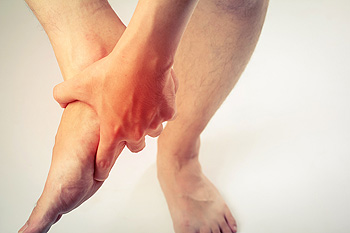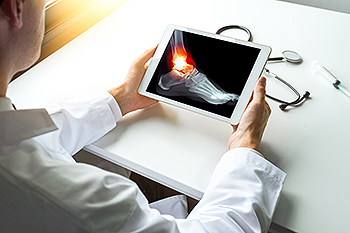

Hammertoe is a foot deformity where one or more toes bend abnormally at the middle joint, resembling a hammer. It often results from muscle imbalance, causing ligaments and tendons to become tight and toes to curl downward instead of lying flat. Common causes include wearing ill-fitting shoes, especially those with narrow toe boxes or high heels, which can crowd the toes and force them into unnatural positions. Additionally, genetics, trauma, and certain medical conditions, such as arthritis, can contribute to hammertoe development. Treatment options range from conservative measures to surgery, depending on the severity of the condition. Conservative approaches may involve wearing properly fitting shoes with a roomy toe box, using orthotic inserts or pads to relieve pressure, and performing toe exercises to strengthen muscles. In more severe cases, where pain persists or mobility is significantly affected, surgical correction may be recommended to realign the toes and restore normal function. If you have a hammertoe that is causing discomfort, it is suggested that you schedule an appointment with a podiatrist for treatment that is deemed appropriate for you.
Hammertoe
Hammertoes can be a painful condition to live with. For more information, contact Dr. Harris L. Klear from Burlington County Podiatry Associates. Our doctor will answer any of your foot- and ankle-related questions.
Hammertoe is a foot deformity that affects the joints of the second, third, fourth, or fifth toes of your feet. It is a painful foot condition in which these toes curl and arch up, which can often lead to pain when wearing footwear.
Symptoms
Causes
Genetics – People who are genetically predisposed to hammertoe are often more susceptible
Arthritis – Because arthritis affects the joints in your toes, further deformities stemming from arthritis can occur
Trauma – Direct trauma to the toes could potentially lead to hammertoe
Ill-fitting shoes – Undue pressure on the front of the toes from ill-fitting shoes can potentially lead to the development of hammertoe
Treatment
Orthotics – Custom made inserts can be used to help relieve pressure placed on the toes and therefore relieve some of the pain associated with it
Medications – Oral medications such as anti-inflammatories or NSAIDs could be used to treat the pain and inflammation hammertoes causes. Injections of corticosteroids are also sometimes used
Surgery – In more severe cases where the hammertoes have become more rigid, foot surgery is a potential option
If you have any questions please contact one of our offices located in Marlton and Delran, NJ . We offer the newest diagnostic and treatment technologies for all your foot and ankle needs.
 Plantar fasciitis is a primary cause of heel pain in adults. The pain stems from the inflammation of the plantar fascia, a band of tissue that spans the bottom of the foot and connects the heel bone to the toes. This condition typically results from repetitive strain and overstretching of the plantar fascia. It is often exacerbated wearing inadequate footwear, obesity, and activities that place excessive stress on the foot. The pain is usually most intense with the first few steps in the morning or after periods of rest. It stems from micro-tears and inflammation within this critical support structure of the foot. As the plantar fascia bears the brunt of every step's impact, its compromised state can significantly hinder mobility and quality of life. Effective management and treatment hinge on a comprehensive approach that may include rest, anti-inflammatory medications, stretching exercises, and possibly orthotic support. If you are suffering from heel pain, it is suggested that you consult with a podiatrist. This type of doctor has specialized knowledge of the foot and ankle, and can diagnose plantar fasciitis and offer personalized treatment solutions.
Plantar fasciitis is a primary cause of heel pain in adults. The pain stems from the inflammation of the plantar fascia, a band of tissue that spans the bottom of the foot and connects the heel bone to the toes. This condition typically results from repetitive strain and overstretching of the plantar fascia. It is often exacerbated wearing inadequate footwear, obesity, and activities that place excessive stress on the foot. The pain is usually most intense with the first few steps in the morning or after periods of rest. It stems from micro-tears and inflammation within this critical support structure of the foot. As the plantar fascia bears the brunt of every step's impact, its compromised state can significantly hinder mobility and quality of life. Effective management and treatment hinge on a comprehensive approach that may include rest, anti-inflammatory medications, stretching exercises, and possibly orthotic support. If you are suffering from heel pain, it is suggested that you consult with a podiatrist. This type of doctor has specialized knowledge of the foot and ankle, and can diagnose plantar fasciitis and offer personalized treatment solutions.
Many people suffer from bouts of heel pain. For more information, contact Dr. Harris L. Klear of Burlington County Podiatry Associates. Our doctor can provide the care you need to keep you pain-free and on your feet.
Causes of Heel Pain
Heel pain is often associated with plantar fasciitis. The plantar fascia is a band of tissues that extends along the bottom of the foot. A rip or tear in this ligament can cause inflammation of the tissue.
Achilles tendonitis is another cause of heel pain. Inflammation of the Achilles tendon will cause pain from fractures and muscle tearing. Lack of flexibility is also another symptom.
Heel spurs are another cause of pain. When the tissues of the plantar fascia undergo a great deal of stress, it can lead to ligament separation from the heel bone, causing heel spurs.
Why Might Heel Pain Occur?
Treatments
Heel pain should be treated as soon as possible for immediate results. Keeping your feet in a stress-free environment will help. If you suffer from Achilles tendonitis or plantar fasciitis, applying ice will reduce the swelling. Stretching before an exercise like running will help the muscles. Using all these tips will help make heel pain a condition of the past.
If you have any questions please contact one of our offices located in Marlton and Delran, NJ . We offer the newest diagnostic and treatment technologies for all your foot and ankle needs.

Proper footwear is important for your child's general foot health. Children's foot bones are soft cartilage in the first few years of life, so they need space to grow naturally. Ignoring foot health can also lead to leg and back problems later in life. Going barefoot sometimes can help with natural development, shoes are necessary for warmth, protection, and support. When buying shoes, measure your child's feet regularly and ensure there's enough room for their feet to grow. Ignore marked shoe sizes and focus on inner length measurements, which is the measurement of the inside of the shoe from the toe to heel. It is normal for shoes to look big on toddlers, as their feet grow rapidly. Look for shoes that are foot-shaped, breathable, flexible, and have a back, regardless of the season. Remember, every pair of shoes is important in shaping your child's foot health for life. If you are a parent and want to ensure that your child’s footwear is best for their foot health, it is suggested that you take your child to a podiatrist for an exam, proper foot measurement, and discussion of what type of shoes would best suit your child’s feet for healthy growth.
The health of a child’s feet is vital to their overall well-being. If you have any questions regarding foot health, contact Dr. Harris L. Klear of Burlington County Podiatry Associates. Our doctor can provide the care you need to keep you pain-free and on your feet.
Tips for Keeping Children's Feet Healthy
If you have any questions, please feel free to contact one of our offices located in Marlton and Delran, NJ . We offer the newest diagnostic and treatment technologies for all your foot care needs.

A fractured bone occurs when external force exceeds bone strength, resulting in pain, limited function, and potential bleeding. Bones are composed of calcium reinforced connective tissue with bone marrow producing blood cells. Bones support the body, aid movement, and shield internal organs. Fracture severity varies based on force, bone involved, age, and health. Common fractures include ankle fractures, more prevalent among older adults. Causes include accidents and conditions like osteoporosis. Symptoms include pain, swelling, and deformity. If you have sustained an ankle fracture, it is suggested that you schedule an appointment with a podiatrist as quickly as possible to ensure proper healing and regain optimal function.
Broken ankles need immediate treatment. If you are seeking treatment, contact Dr. Harris L. Klear from Burlington County Podiatry Associates. Our doctor can provide the care you need to keep you pain-free and on your feet.
Broken Ankles
A broken ankle is experienced when a person fractures their tibia or fibula in the lower leg and ankle area. Both of these bones are attached at the bottom of the leg and combine to form what we know to be our ankle.
When a physician is referring to a break of the ankle, he or she is usually referring to a break in the area where the tibia and fibula are joined to create our ankle joint. Ankles are more prone to fractures because the ankle is an area that suffers a lot of pressure and stress. There are some obvious signs when a person experiences a fractured ankle, and the following symptoms may be present.
Symptoms of a Fractured Ankle
If you suspect an ankle fracture, it is recommended to seek treatment as soon as possible. The sooner you have your podiatrist diagnose the fracture, the quicker you’ll be on the way towards recovery.
If you have any questions, please feel free to contact one of our offices located in Marlton and Delran, NJ . We offer the newest diagnostic and treatment technologies for all your foot care needs.